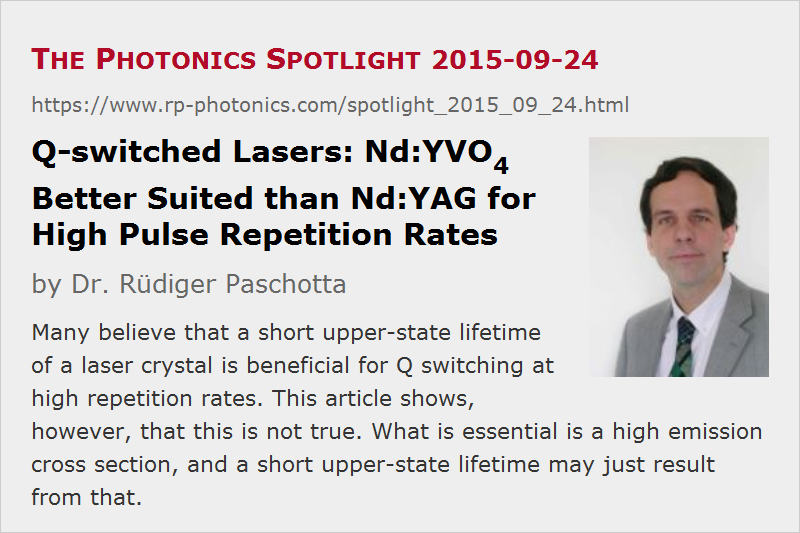Q-switched Lasers: Nd:YVO4 Better Suited than Nd:YAG for High Pulse Repetition Rates
Posted on 2015-09-24 as a part of the Photonics Spotlight (available as e-mail newsletter!)
Permanent link: https://www.rp-photonics.com/spotlight_2015_09_24.html
Author: Dr. Rüdiger Paschotta, RP Photonics Consulting GmbH
Abstract: Many believe that a short upper-state lifetime of a laser crystal is beneficial for Q switching at high repetition rates. This article shows, however, that this is not true. What is essential is a high emission cross section, and a short upper-state lifetime may just result from that.

It is quite well known than when building a Q-switched laser for operation with a high pulse repetition rate (e.g. 100 kHz), an Nd:YVO4 laser crystal is better suited than a Nd:YAG crystal. What is not so well known, however, is the reason for that.
Many believe that the shorter upper-state lifetime of Nd:YVO4 is the reason. This is wrong, however. The perhaps most compelling proof of that statement is obtained by considering a hypothetical laser crystal which has the same properties as Nd:YAG except that its upper-state lifetime is strongly reduced (e.g. by some quenching process); one could demonstrate with a numerical model, for example, that this would not work better (even worse!) than Nd:YAG.
On the other hand, a hypothetical laser crystal with the properties of Nd:YVO4, except for a long upper-state lifetime as for Nd:YAG, would work well – only that such a combination is physically not possible, since the upper-state lifetime cannot be longer than the radiative lifetime: the lifetime is limited by the population decay through spontaneous emission.
The real problem with Nd:YAG for operation at high pulse repetition rates is totally different and not related to the upper-state lifetime. In this regime, there is only very limited time for pumping between the emission of two pulses. Therefore, one can deposit only a quite limited amount of energy in the laser crystal, and consequently one obtains a rather small laser gain. This leads to a slow rise of optical power after opening the Q switch. The resulting pulse than exhibits a rather long pulse duration and correspondingly low peak power; it can even happen that the available time is not sufficient for generating the pulse, so that only e.g. every second pulse is emitted: the laser operates with a lower pulse repetition rate than desired. One may also obtain an unstable regime.
The described problem is much reduced when using Nd:YVO4, because that gain medium has a much higher gain efficiency: it delivers more decibels of gain per millijoule of stored energy. The high gain efficiency results from a very high emission cross section (roughly 4 times higher than for Nd:YVO4).
The above-described misconception may be related to the following aspects:
- It is true that a short upper-state lifetime can be a problem for operation with low repetition rates (limited energy storage). This does not imply, however, that a long upper-state lifetime is bad for high repetition rates.
- Gain media with high emission cross sections tend to have short upper-state lifetimes. However, the short upper-state lifetime is then just another consequence, rather than the reason for the better laser performance.
One could also increase the gain efficiency by working with a reduced mode area in the laser crystal. However, there are limits to this approach, set e.g. by the limited pump beam quality (particularly for high-power lasers) or by thermal effects.
For designing such lasers, one should definitely have a good qualitative and quantitative understanding of the laser dynamics, because this is essential for finding appropriate parameter values (e.g. concerning the chosen laser crystal, the mode size in the crystal, the resonator length, etc.). For Q-switched bulk lasers (not for fiber lasers), it is often sufficient (at least for rough estimates) to use some relatively simple equations, which might even be solved on a pocket calculator. More sophisticated numerical models are required if certain additional effects are of interest, such as gain guiding (which might strongly affect the obtained beam diameter) or a limited speed of the Q-switch.
This article is a posting of the Photonics Spotlight, authored by Dr. Rüdiger Paschotta. You may link to this page and cite it, because its location is permanent. See also the RP Photonics Encyclopedia.
Note that you can also receive the articles in the form of a newsletter or with an RSS feed.
Questions and Comments from Users
Here you can submit questions and comments. As far as they get accepted by the author, they will appear above this paragraph together with the author’s answer. The author will decide on acceptance based on certain criteria. Essentially, the issue must be of sufficiently broad interest.
Please do not enter personal data here; we would otherwise delete it soon. (See also our privacy declaration.) If you wish to receive personal feedback or consultancy from the author, please contact him e.g. via e-mail.
By submitting the information, you give your consent to the potential publication of your inputs on our website according to our rules. (If you later retract your consent, we will delete those inputs.) As your inputs are first reviewed by the author, they may be published with some delay.
 |






If you like this page, please share the link with your friends and colleagues, e.g. via social media:
These sharing buttons are implemented in a privacy-friendly way!